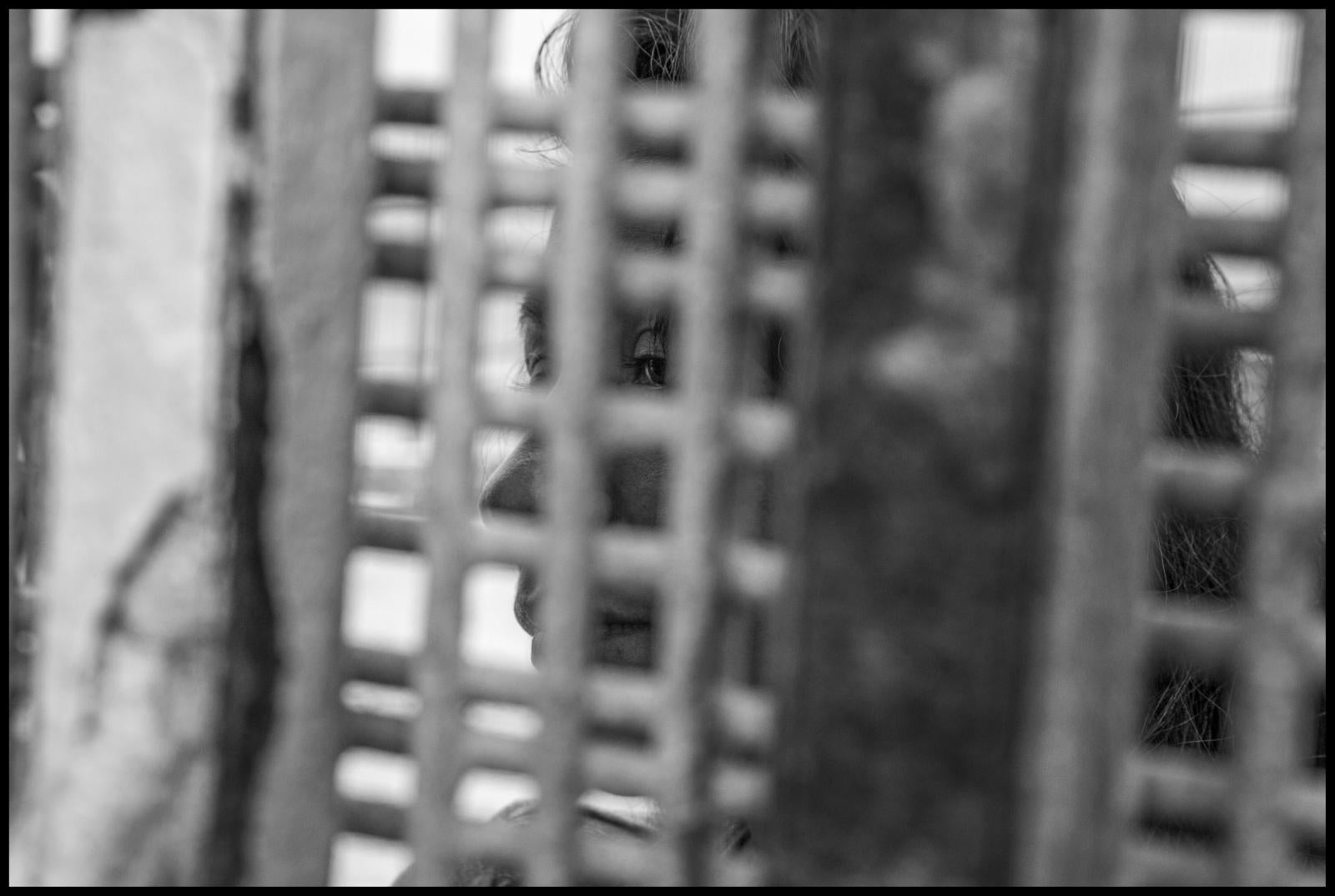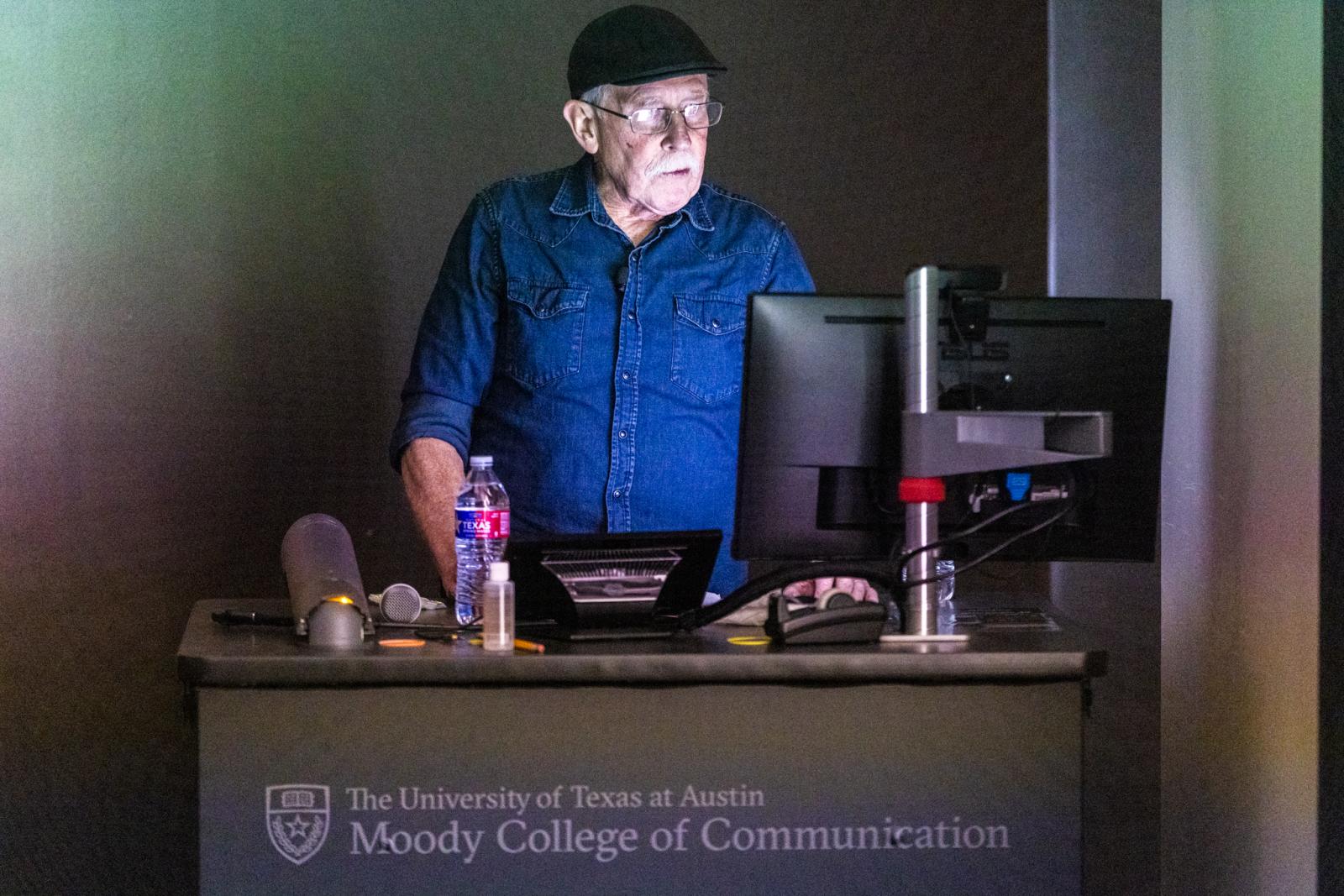A Q&A with Photojournalist David Bacon
It is difficult to see in one of photojournalist David Bacon’s gripping black and white images: the forlorn face of a woman peering through a wrought iron fence, her single eye visible between the bars as she greets family members separated on the other side of the U.S.-Mexico border.
It is one of many captivating images that make up Bacon’s three decades of work documenting the labor movement and social justice issues on the border. And it's one that's impossible to ignore, highlighting the border wall's impact on families split between two sides.

This and many other pivotal images from Bacon's collection are now featured in the School of Journalism and Media’s new Photojournalism Gallery. Bacon is its inaugural artist, and his captivating black and white photography will grace the walls of the Dealey Center for New Media through March. The gallery is meant to celebrate the art of still photography, something that’s been lost amid our social media culture, where people are inundated with photos so much they forget to look.
Bacon visited Moody College in January to talk to students about his work and the importance of photojournalism with a social justice cause. In an interview with Moody College, he gave young photojournalists advice, on how to capture captivating photos and to thrive in their careers despite the many challenges in journalism today. Read what he had to say.
This article has been edited for clarity and length.
We are living in an age where we see more photos than ever before, scrolling on our phones. Everyone is a photographer. Can you speak to the value of still photography? Why is it important today for students to have that skill?
It’s true that we are surrounding by millions of photographs all the time, more and more. But we don’t look. And see the individual image very much. In fact, we’re kind of being trained not to do that. So I think it’s very important to slow down, and first of all, learn to look.
For people who are coming into photography, obviously mastering the tool is an important thing. I think it’s also important for photographers to learn film, take up a film camera, learn how to shoot it and learn how to process it. All of the digital tools are built on what happened in film. All the things you can do in Photoshop, adjusting exposure, contrast, color are things you learn to do in the dark room. And the dark room adjustments were transferred into the digital world. But I think that using a film camera and learning to develop film also slows you down and makes you pay attention to the individual image. The magic of seeing the image appear on the paper in the tray. It really makes you much more interested in photography than you were before. Then you can take those skills and transfer them to the digital world and understand it better and use it in a more conscious way. Our technology allows us to do things that we couldn’t do before, but we have to use the technology and not let the technology use us. In the end, the camera is just a stupid tool, and we have to control it and what it does, and to do that, we have to pay attention to the image itself.
I also think it’s important for people who are developing as photographers to look at the work of other people. The advantage of doing it with a book is you can keep looking at the image on the page for quite a while. With a screen we’re always tempted to go on to something else. Pay attention to the image, how it’s constructed, what was going on between the photographer and the subject and the aesthetics. Photography is a craft, an art. We have to be conscious about how we make the photograph.
How do you make your subjects comfortable so that you begin to blend into the background?
A lot of students feel uncomfortable because they haven’t yet decided who they are. As a photographer, for instance, in order to take effective photographs you have to get close to people, violate people’s space. In our culture, the closer you get physically, the more uncomfortable you get. As a photographer you’re often more uncomfortable than the person you are approaching.
I think people will ignore you and you will blend into the background once they are comfortable and used to you being there. Some things have to come before that. I think when you’re in a situation where you are taking photographs and documenting, you have to talk to people, and you have to understand who you are talking to. You have to look at yourself as someone more than just a person taking the notes, someone more than the person clicking the shutter.

What would you tell students about how to find good stories?
Look at your own life and document what’s around you. Learn how to take things that seem uninteresting on the surface and create interesting images. I think one genre of photographer that is a good training is street photography. That means you take your camera, and you go walking and you document what you see. Shooting what you find is a good way of training your eye. Then also street photography can lead you to documenting other important things.
The other thing that helps is to look at the world around you and ask, what upsets you? What are you bothered by? Then think about how you can produce images that relate to these things that bother you. There are a lot of things in this world that you can feel bothered by. You look at the world and see the injustices. The question is: now what? How can you take photographs that are in some way relevant to that.
What is the most difficult thing about your work?
The most difficult thing is making a living from it. I think this is something students need to think about right away. There used to be a traditional career path for a journalist. You went to journalism school and got a job in newspapers. That is still there if you are willing to make some compromises and sacrifices. But the number of jobs in daily newspapers is far fewer than it used to be. And the media world has changed. The breaking stories in our world are typically not broken in daily newspapers. They are broken in digital media.
Like it or not, most of us are going to be freelancers, at least for part of our working life. And that presents problems. It has for me. First thing, that means is that you have to sell your work. You build relationships with editors and gatekeepers who you want to use your work. Your relationship with them is not like employee to employer. The economics of it at this point are problematic. Reporting for digital media sometimes the rates are really low. How are we going to pay the rent? There are a lot of us who are working other jobs and also still trying to do freelance work. It’s not unusual. It’s just life. But I think it tells us something about what we need to do to survive in the work we want to do. This is not a problem you are going to be able to solve as an individual. The structure of this industry has changed in a way that the rates we are being paid are not livable. This is why we have unions. We have to figure this one out.
What about the most rewarding?
The things I enjoy about it are doing the work. I like doing the work. I like talking to people. I like taking the photographs. I like doing the selection. Nothing comes out of the camera as a compete processed image, so I like the process.
I do a lot of conversion from color into black and white. I always think when I take the image, what it is going to look like in black and white? Sometimes if you take a really good image, it can feel really good. I produced something that makes me feel fulfilled as a creative person. That’s the part I really like the most.
The part I hate is making myself sit down to do it. It goes back to when you were in high school and had to do a book report and you delayed and delayed. And you were up against it and had to do it. You carry those bad habits with you the rest of your life.
Your work is hanging downstairs now for people do view. What do you hope they take from their work?
I hope that it inspires to students to work that reflects the reality that they see and that it makes students more interested in photography that has a social justice content to it. It was such an honor to me to have these photographs on the wall of the journalism school here. I just feel very grateful to the school for having done this. If the students have reactions to it, criticisms and questions about it, I hope that they get in touch with me. That would be very fulfilling to me.
